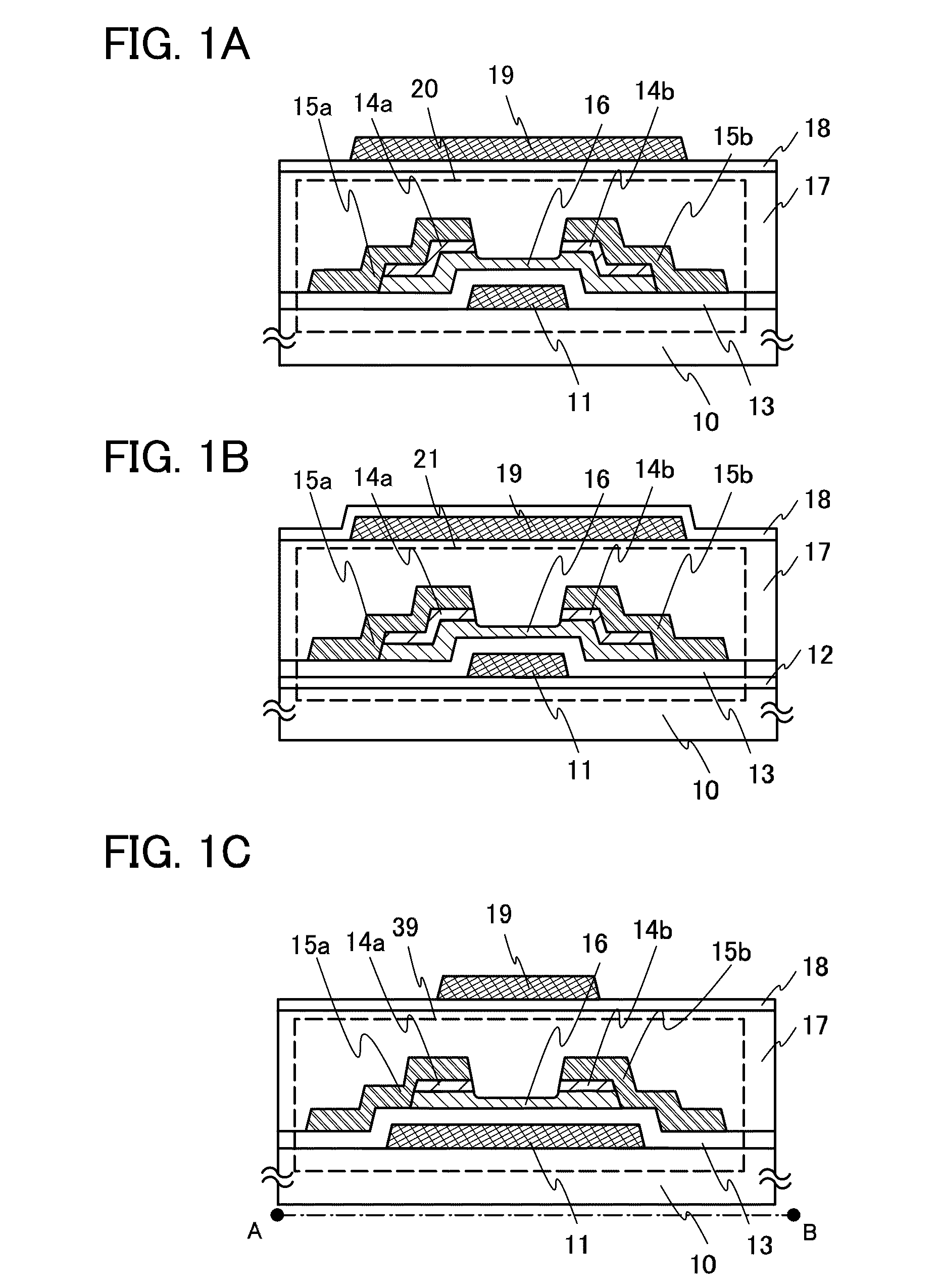Semiconductor device
a technology of semiconductor devices and semiconductors, applied in the direction of semiconductor devices, electrical equipment, transistors, etc., can solve the problem of increasing the power consumption of semiconductor devices
- Summary
- Abstract
- Description
- Claims
- Application Information
AI Technical Summary
Benefits of technology
Problems solved by technology
Method used
Image
Examples
embodiment 1
[0090]FIG. 1A is an example of a cross-sectional view of a thin film transistor in which an oxide semiconductor layer is sandwiched between two gate electrodes provided over and below the oxide semiconductor layer. This embodiment describes an example of a manufacturing method by which a thin film transistor used for a pixel portion and a driver circuit is provided over a substrate having an insulating surface.
[0091]First, a first gate electrode 11 is formed over a substrate 10 having an insulating surface. As the substrate 10 having an insulating surface, any glass substrate used in the electronics industry (also called an alkali-free glass substrate) such as an aluminosilicate glass substrate, an aluminoborosilicate glass substrate, or a barium borosilicate glass substrate, a plastic substrate with heat resistance which can withstand a process temperature in this manufacturing process, or the like can be used. In the case where the substrate 10 is mother glass, the substrate may h...
embodiment 2
[0126]FIG. 2A is an example of a cross-sectional view of a thin film transistor in which an oxide semiconductor layer is sandwiched between two gate electrodes provided over and below the oxide semiconductor layer. This embodiment describes an example of a manufacturing method by which a thin film transistor used for a pixel portion and a driver circuit is provided over a substrate having an insulating surface.
[0127]The same steps as Embodiment 1 are employed from formation of the first gate electrode 11 over the substrate 10 having an insulating surface up to formation of the first gate insulating layer 13 covering the first gate electrode 11. Therefore, detailed description is omitted here and the same portions as those of FIG. 1A are denoted by the same reference numerals.
[0128]A conductive film is formed from a metal material over the first gate insulating layer 13 by a sputtering method or a vacuum evaporation method. In this embodiment, a three-layer structure of a Ti film, an...
embodiment 3
[0156]FIG. 3A is an example of a cross-sectional view of a thin film transistor in which an oxide semiconductor layer is sandwiched between two gate electrodes provided over and below the oxide semiconductor layer. This embodiment describes an example of a manufacturing method by which a thin film transistor used for a pixel portion and a driver circuit is provided over a substrate having an insulating surface.
[0157]Note that steps in which the first gate electrode 11 is formed over the substrate 10 having an insulating surface, the first gate insulating layer 13 covering the first gate electrode 11 is formed, and an oxide semiconductor film is formed are the same as those of Embodiment 1. Therefore, detailed description is omitted here and the same portions as those of FIG. 1A are denoted by the same reference numerals.
[0158]In this embodiment, an oxide semiconductor film over the first gate insulating layer 13 is formed using a Zn—O-based oxide semiconductor target including SiO2 ...
PUM
 Login to View More
Login to View More Abstract
Description
Claims
Application Information
 Login to View More
Login to View More - R&D
- Intellectual Property
- Life Sciences
- Materials
- Tech Scout
- Unparalleled Data Quality
- Higher Quality Content
- 60% Fewer Hallucinations
Browse by: Latest US Patents, China's latest patents, Technical Efficacy Thesaurus, Application Domain, Technology Topic, Popular Technical Reports.
© 2025 PatSnap. All rights reserved.Legal|Privacy policy|Modern Slavery Act Transparency Statement|Sitemap|About US| Contact US: help@patsnap.com



